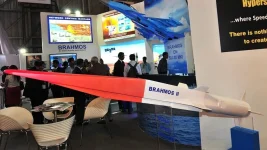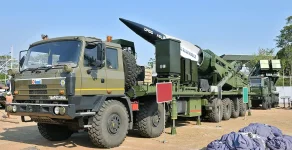- Views: 1K
- Replies: 5
The BrahMos-NG (Next Generation), a compact and advanced iteration of the Indo-Russian BrahMos supersonic cruise missile, is set to redefine India’s aerial strike capabilities.
With a reduced weight, smaller size, and an increased speed of Mach 3.5, the BrahMos-NG is designed to be nearly impossible to intercept, posing a formidable challenge to adversaries like Pakistan.
When air-launched from platforms like the HAL Tejas Mk1A, which can carry two of these missiles, the BrahMos-NG promises to enhance the Indian Air Force’s (IAF) precision and deterrence in the subcontinent’s volatile geopolitical landscape.
The BrahMos-NG is a sleeker, lighter, and more advanced version of the original BrahMos missile, which is renowned for its Mach 2.8–3.0 speed and precision strike capabilities.
Developed by BrahMos Aerospace, a joint venture between India’s Defence Research and Development Organisation (DRDO) and Russia’s NPO Mashinostroyeniya, the NG variant is optimized for integration with a wider range of platforms, including smaller fighters like the Tejas Mk1A.
Its key features include:
- Reduced Size and Weight: Weighing approximately 1.3–1.5 tons and measuring 5–6 meters in length with a 50 cm diameter, the BrahMos-NG is 50% lighter and up to three meters shorter than its predecessor, which weighs 2.5–3 tons. This compact design allows smaller aircraft like the Tejas Mk1A to carry two missiles, significantly enhancing their combat potential.
- Increased Speed: With a speed of Mach 3.5 (approximately 4,320 km/h), the BrahMos-NG is faster than the original, reducing the reaction time for enemy air defences and making interception extremely difficult. Its high kinetic energy enhances target penetration, surpassing subsonic missiles like the Tomahawk, which has 32 times less on-cruise kinetic energy.
- Stealth Features: The BrahMos-NG boasts a lower radar cross-section (RCS) due to its smaller size and advanced materials, making it harder for radar systems to detect. It also incorporates an Active Electronically Scanned Array (AESA) radar for guidance, replacing the mechanically scanned radar of the original BrahMos, improving resistance to electronic countermeasures and enhancing precision.
- Multi-Platform Versatility: Designed for air, land, sea, and submarine-launched variants, the BrahMos-NG can be fired from torpedo tubes of submarines like the P75I class and mounted on fighters such as the Sukhoi Su-30MKI, MiG-29UPG, Mirage 2000, and Tejas. The Su-30MKI can carry up to four NG missiles, while the Tejas Mk1A can carry two, a significant upgrade for the lightweight fighter.
Challenges for Pakistan’s Air Defences
Pakistan’s air defence network, primarily reliant on Chinese-supplied systems like the HQ-9 (a derivative of the Russian S-300) and HQ-16FE, struggles to counter the BrahMos-NG’s capabilities.The missile’s Mach 3.5 speed and low-altitude flight profile (5–15 meters in the terminal phase) drastically reduce detection and engagement windows, often to less than 10 seconds. Key challenges include:
- Interception Difficulty: The HQ-9, Pakistan’s most advanced surface-to-air missile system, has a maximum engagement speed of Mach 4.2 and a reaction time of 12–15 seconds. The BrahMos-NG’s high speed and low RCS make it nearly impossible to track and engage effectively, as demonstrated during Operation Sindoor in May 2025, where BrahMos missiles struck 11 of 12 targeted Pakistani airbases without interception.
- Electronic Warfare Limitations: Pakistan’s claims of using “soft kill” measures like jamming or spoofing to neutralize BrahMos missiles are questionable. The BrahMos-NG’s advanced ECCM (electronic counter-countermeasures) and multi-mode guidance (inertial, satellite, and active radar) make it highly resistant to such tactics.
- Strategic Impact: The BrahMos-NG’s ability to target critical infrastructure, such as Pakistan’s Noor Khan airbase in Rawalpindi, demonstrated during Operation Sindoor, underscores its role as a game-changer. The Tejas Mk1A’s deployment with two BrahMos-NG missiles amplifies this threat, enabling India to conduct deep strikes with minimal risk to pilots.
The 2025 India-Pakistan standoff highlighted the BrahMos’s devastating effectiveness, with 15 missiles crippling Pakistan’s air defences and forcing a ceasefire.


